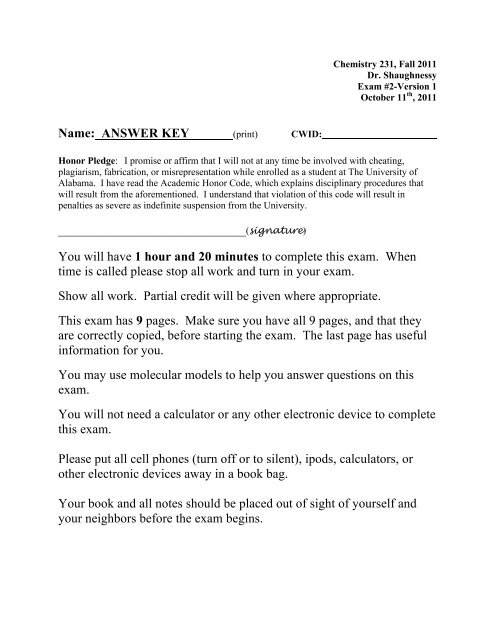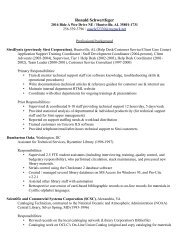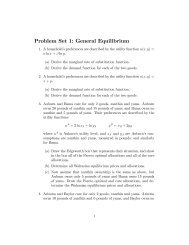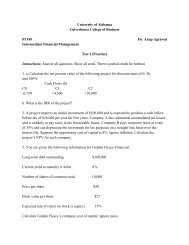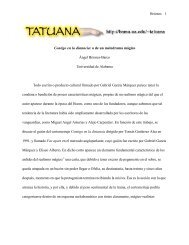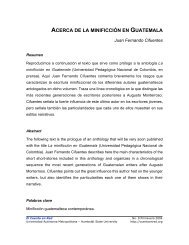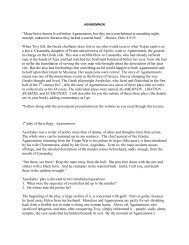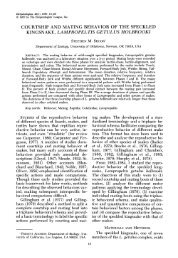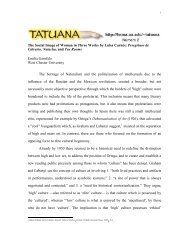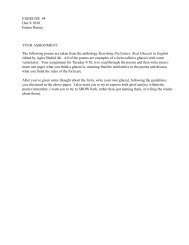Name: ANSWER KEY - Bama.Ua.Edu - The University of Alabama
Name: ANSWER KEY - Bama.Ua.Edu - The University of Alabama
Name: ANSWER KEY - Bama.Ua.Edu - The University of Alabama
Create successful ePaper yourself
Turn your PDF publications into a flip-book with our unique Google optimized e-Paper software.
<strong>Name</strong>: <strong>ANSWER</strong> <strong>KEY</strong> (print) CWID:<br />
Chemistry 231, Fall 2011<br />
Dr. Shaughnessy<br />
Exam #2-Version 1<br />
October 11 th , 2011<br />
Honor Pledge: I promise or affirm that I will not at any time be involved with cheating,<br />
plagiarism, fabrication, or misrepresentation while enrolled as a student at <strong>The</strong> <strong>University</strong> <strong>of</strong><br />
<strong>Alabama</strong>. I have read the Academic Honor Code, which explains disciplinary procedures that<br />
will result from the aforementioned. I understand that violation <strong>of</strong> this code will result in<br />
penalties as severe as indefinite suspension from the <strong>University</strong>.<br />
_____________________________(signature)<br />
You will have 1 hour and 20 minutes to complete this exam. When<br />
time is called please stop all work and turn in your exam.<br />
Show all work. Partial credit will be given where appropriate.<br />
This exam has 9 pages. Make sure you have all 9 pages, and that they<br />
are correctly copied, before starting the exam. <strong>The</strong> last page has useful<br />
information for you.<br />
You may use molecular models to help you answer questions on this<br />
exam.<br />
You will not need a calculator or any other electronic device to complete<br />
this exam.<br />
Please put all cell phones (turn <strong>of</strong>f or to silent), ipods, calculators, or<br />
other electronic devices away in a book bag.<br />
Your book and all notes should be placed out <strong>of</strong> sight <strong>of</strong> yourself and<br />
your neighbors before the exam begins.
Version 1: White<br />
Problem Score<br />
1 (12)<br />
2 (20)<br />
3 (22)<br />
4 (18)<br />
5 (16)<br />
6 (16)<br />
Total (100)<br />
<strong>The</strong>re are a total <strong>of</strong> 104 points, but the exam<br />
is worth 100 points.<br />
2
Version 1: White<br />
1. For each problem below, circle the best answer. In each case, there is only one correct<br />
answer (12 points)<br />
a. Which substituent would have the highest priority in the Cahn-Ingold-Prelog rules? <strong>The</strong><br />
point <strong>of</strong> attachment to the stereocenter is the arrow.<br />
F<br />
I<br />
b. Which molecule below is not chiral?<br />
O<br />
B O<br />
F<br />
CH 3<br />
c. Which carbocation would be the most stable?<br />
d. Which molecule below would not have an index <strong>of</strong> hydrogen deficiency <strong>of</strong> 3?<br />
O<br />
Br<br />
e. Which molecule below is a meso compound?<br />
Br<br />
Br<br />
H 3C<br />
C<br />
f. Which molecule below would be least likely to act as a Lewis acid in a reaction?<br />
H Cl<br />
F F O<br />
Br OH<br />
H<br />
B<br />
H H<br />
N<br />
Mg 2+<br />
OH<br />
Br F CH HO OH<br />
3<br />
CH3 HO 2C<br />
CH 3<br />
Br<br />
H 3C CH 3<br />
Br<br />
SnH 3<br />
CO 2H<br />
3
Version 1: White<br />
2. For each reaction below, provide the missing starting material(s) or product(s). Provide the<br />
starting material that would give the provided product as the only product. Draw the major<br />
product or products expected. You may ignore stereochemistry in drawing the starting<br />
materials or products. (20 points)<br />
a.<br />
b.<br />
c.<br />
d.<br />
O<br />
N<br />
O<br />
OH<br />
+<br />
+<br />
HBr<br />
S<br />
+ HCl<br />
H 2O<br />
H 2SO 4 (cat)<br />
Two products formed<br />
O<br />
N<br />
O<br />
O<br />
Br<br />
OH<br />
Cl<br />
Cl<br />
H<br />
S<br />
4
Version 1: White<br />
3. Stereocenter configurations and nomenclature. (22 points)<br />
a. Provide the missing name for compound below. Be sure to indicate any stereochemical<br />
configurations in your name.<br />
(4Z,6S)-2,6-dimethyl-3,5-dipropyl-2,4-octadiene<br />
b. For each molecule below, provide the R/S or E/Z configurations for each chiral center or<br />
stereogenic alkene.<br />
O<br />
O<br />
F<br />
F<br />
Circle the highest priority<br />
substituents on each alkene<br />
carbon and assign as E or Z<br />
Z<br />
Dextromethorphan-cough suppressent in<br />
Robutussin, Nyquil, Vicks, Dimetapp, etc<br />
H 3CO<br />
N<br />
H<br />
CH 3<br />
3<br />
2<br />
2<br />
H<br />
1<br />
4<br />
3<br />
S<br />
Label the substituents on each circled<br />
chiral center in order <strong>of</strong> priority and then<br />
assign the R or S configuration<br />
b. Label each pair <strong>of</strong> molecule below as identical, enantiomers, or diastereomers.<br />
H 2N H<br />
H NH2<br />
Cl<br />
Cl<br />
Diastereomers<br />
S<br />
4<br />
1<br />
HO<br />
H<br />
Br<br />
HO H<br />
Br<br />
Enantiomers<br />
5
Version 1: White<br />
4. Compare the acidity <strong>of</strong> the two amines shown below. (18 points)<br />
a. Draw the key resonance structures that help to stabilize the negative charge in the<br />
conjugate bases below.<br />
i.<br />
ii.<br />
H<br />
O<br />
H<br />
O<br />
NH 2<br />
NH 2<br />
C<br />
O<br />
NH<br />
H<br />
-H +<br />
-H +<br />
H<br />
H<br />
O<br />
NH<br />
b. Which compound would you predict to be more acidic? In 2 sentences, or less, support<br />
your answer.<br />
NH<br />
<strong>The</strong> molecule in part i is more acidic. It has one additional resonance structure than ii,<br />
where the negative charge can be moved onto the oxygen.<br />
NH<br />
C<br />
O<br />
<strong>The</strong>re is no way to move the negative<br />
charge onto the aldehyde oxygen<br />
O<br />
NH<br />
H<br />
C<br />
O<br />
H<br />
H<br />
H<br />
O<br />
O<br />
NH<br />
NH<br />
NH<br />
NH<br />
C<br />
O<br />
C<br />
O<br />
H<br />
H<br />
6
Version 1: White<br />
5. For each reaction below, circle the side <strong>of</strong> the reaction that would be favored. You have not<br />
been provided pKa values, so use your knowledge <strong>of</strong> how the structure <strong>of</strong> an acid affects its<br />
relative acidity. Provide a short (one sentence) explanation for the direction <strong>of</strong> the<br />
equilibrium. (16 points)<br />
a.<br />
b.<br />
c.<br />
d.<br />
H 3CS<br />
O<br />
OH<br />
A<br />
O<br />
O<br />
+ +<br />
Cl<br />
H<br />
O<br />
3CS<br />
O<br />
B is a stronger acid than A because Cl is a stronger inductive electron-withdrawing<br />
group than SCH 3.<br />
F + HCl HF + Cl<br />
HCl is a stronger acid than HF because Cl is larger than F (lower on periodic table).<br />
O<br />
O<br />
NH<br />
O<br />
+ H N +<br />
O<br />
N is more electronegative than C, so the N-H bond is more acidic.<br />
H C N + C C H<br />
C N + H C C H<br />
HCN is a stronger acid than acetylene because <strong>of</strong> the higher inductive<br />
withdrawing effect <strong>of</strong> N vs. C.<br />
O<br />
O<br />
O<br />
O<br />
H<br />
H<br />
Cl<br />
O<br />
B<br />
7<br />
OH
Version 1: White<br />
6. Shown below is the synthesis <strong>of</strong> methyl tert-butyl ether (MTBE). MTBE was used as a<br />
gasoline additive, but its use was discontinued due to problems with it contaminating<br />
groundwater. Provide a detailed mechanism for this reaction that shows each intermediate.<br />
Use arrows to show electron motion and indicate any formal charges. Note that the reactivity<br />
<strong>of</strong> methanol (CH3OH) is similar to that <strong>of</strong> water. (16 points)<br />
+<br />
+ HOCH 3<br />
H<br />
O CH3 H<br />
(from HOCH 3<br />
and H 2SO 4)<br />
H<br />
O CH3<br />
H<br />
H 2SO 4<br />
(cat)<br />
+ HOCH 3<br />
OCH 3<br />
methyl tert-butyl ether (MTBE)<br />
H<br />
HOCH 3<br />
OCH 3<br />
H<br />
+ O CH 3<br />
H<br />
H<br />
8
Version 1: White<br />
9


